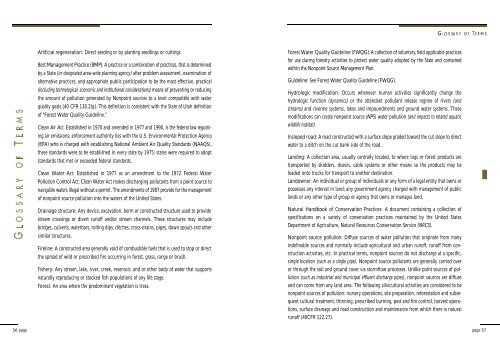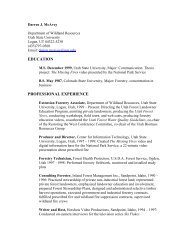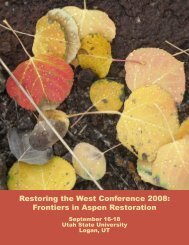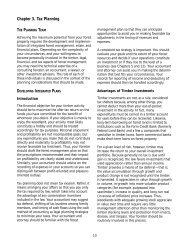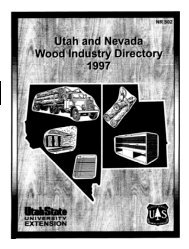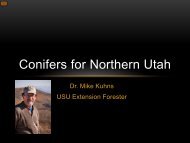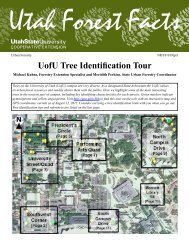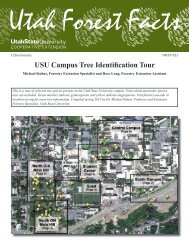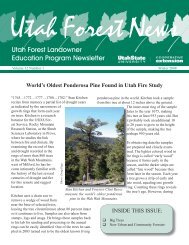A Technical Manual for Landowners, Loggers, and ... - Forestry
A Technical Manual for Landowners, Loggers, and ... - Forestry
A Technical Manual for Landowners, Loggers, and ... - Forestry
You also want an ePaper? Increase the reach of your titles
YUMPU automatically turns print PDFs into web optimized ePapers that Google loves.
R O A D S, S K I D T R A I L S , L A N D I NG S & S T R E A M C R O S S I NG S<br />
R O A D S, S K I D T R A I LS , L A N D I NG S<br />
& S T R E A M C R O S S I NG S<br />
■ Locate l<strong>and</strong>ings to avoid skidding down, or across drainages <strong>and</strong> stre a m s .<br />
■ Restore l<strong>and</strong>ings <strong>and</strong> reseed if necessary, at the end of operations.<br />
St ream Cro s s i n g s<br />
Culverts, bridges <strong>and</strong> <strong>for</strong>ds are all methods used to cross streams. Select a site<br />
<strong>for</strong> a stream crossing be<strong>for</strong>e the road system is laid out or planned. Doing<br />
so will allow the road system to be designed <strong>for</strong> the best approach to the<br />
stream crossing. The profile of the streambed should not be changed when<br />
constructing crossings. Select the most appropriate stream crossing structure<br />
considering the following criteria: stream size, cost, maintenance re q u i re m e n t s ,<br />
<strong>and</strong> whether temporary or permanent. Poorly located or constructed stream<br />
c rossings are costly <strong>and</strong> may contribute to sedimentation <strong>and</strong> erosion. A permit is<br />
re q u i red <strong>for</strong> any stream bank alteration from the Utah Division of Water Rights.<br />
C u lve rt s<br />
Culverts are the most commonly-used <strong>for</strong>m of stream crossing. A culvert is<br />
easily placed, functions well, is relatively inexpensive <strong>and</strong> can be reused upon<br />
removal when no longer needed. Culverts should be of sufficient size to<br />
accommodate peak runoff <strong>and</strong> flood waters. Generally, use of the 25 year - 24<br />
hour storm event <strong>for</strong> temporary road crossings <strong>and</strong> the 50 year - 24 hour<br />
storm event <strong>for</strong> permanent road crossings will provide adequate structure sizing.<br />
Minimum culvert size should be 15 inches in diameter.<br />
Figure 4.11<br />
Recommended Practice St<strong>and</strong>ards <strong>and</strong> Guidelines<br />
■ Use stream crossings only when absolutely necessary.<br />
■ Keep the number of stream crossings to a minimum. Avoid indiscriminate<br />
stream crossings.<br />
■ Identify the appropriate type of stream crossing (e.g. culvert, <strong>for</strong>d or bridge).<br />
■ Select a location that has firm banks <strong>and</strong> fairly level approaches. Design<br />
stream crossings to h<strong>and</strong>le peak runoff <strong>and</strong> flood waters <strong>and</strong> provide <strong>for</strong><br />
adequate fish passage.<br />
■ Install stream crossings at right angles to the channel whenever possible.<br />
■ Construction <strong>and</strong> placement of stream crossings is critical <strong>and</strong> should<br />
be timed to minimize impacts to water quality.<br />
30 o Berm or Block as needed<br />
Outlet Ditch<br />
Recommended Practice St<strong>and</strong>ards <strong>and</strong> Guidelines<br />
■ Place culvert so the bottom is at the same level as the bottom of the ditch<br />
or adjoining slope, at the gradient of the original slope, <strong>and</strong> skewed 15 to<br />
30 degrees toward the inflow ditch to reduce maintenance problems.<br />
■ Cover tops of culverts with at least 12 inches of compacted fill <strong>for</strong> culvert s<br />
up to 36 inches in diameter <strong>and</strong>; cover large culverts with fill material ≥<br />
1/3 of the culvert diameter. This minimizes damage to culverts from<br />
heavy vehicles <strong>and</strong> road maintenance activities.<br />
28 page page 29


